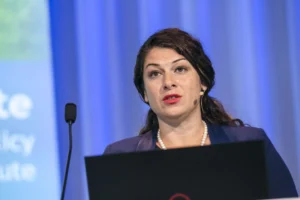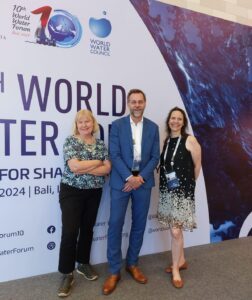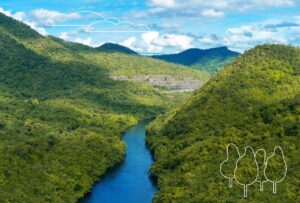Governing the invisible: Putting groundwater centre-stage
Groundwater is often referred to as an ‘invisible resource’. In 1859, an English judge lamented the difficulty to regulate something that is “percolating or oozing through the soil … according to the quantity of rain that may chance to fall”. Even today, with vastly improved sources of data, groundwater governance suffers from large knowledge and awareness gaps that translate into institutional and policy voids, writes SIWI’s Jenny Grönwall.
Groundwater provides half of all drinking water, more than 40 per cent of irrigation water and a third of the industrial sector’s global need for water. Around the world, some 2.5 billion people depend solely on it to satisfy their daily drinking and other domestic water needs. As with water in general, demand for groundwater is increasing because of population growth and new, global consumption patterns. Groundwater depletion is largely driven by irrigated agriculture, to satisfy needs for basic global food security as well as for, what can be seen as, luxury crop outputs. Ever-deeper boreholes and tubewells, and more powerful pumps, put a strain on groundwater reserves that are not rejuvenated in a lifetime. Our shared groundwater resources are also threatened due to climate variability and change, and quality deterioration.
Groundwater governance is key in addressing the multiple concerns and challenges that face the resource and its users. Governance can in short be summarized as involving processes and people: mechanisms and frameworks for decision-making, and actors engaged in, and/or affected by, the outcome of the decisions.
The 2022 theme for World Water Day, set by UN Water, is Groundwater. Read more here.
Global water issues in your inbox
Stay up to date on SIWI's work and related topics from around the world.
Sign up to our newsletter“The understanding of groundwater and aquifer vulnerability to climate change is constantly evolving but it needs to be linked to users’ ability to process complex information. ”
In terms of modes and mechanisms to limit harmful impacts on groundwater resources and aquifers, the regulatory system includes permits and licences. This is a critical part of the command and control approach but one that is notoriously constrained. Challenges involve problems to interpret and administer legal rules and enforce them effectively. Complementary ways of regulating conduct and behaviour are therefore constantly sought.
A complicating factor is that the use and abuse of groundwater is often a local, small-scale matter. If India alone counts more than 20 million pump sets attached to as many tubewells, predominantly owned by individual farmers, it is doubtlessly difficult to rule irrigation practices efficiently from the top.
Notable in the field of groundwater is the ‘tragedy of the commons’ notion of the 1960s, according to which users, acting in their own self-interest, abuse a common good. The theory emerged in light of difficulties in controlling the depletion of a shared resource.
Self-regulating common resources
Elinor Ostrom, political scientist, and recipient of the Nobel Memorial Prize in Economic Sciences, studied groundwater as a typical example of a common pool resource. She came to advocate for countermeasures with ‘governing the commons’ through local institutions that take collective action and decide their own rules for water management. Ostrom’s ideas for self-organization are characteristic of the 1990s when the trend in the wider resources use sector aimed for ‘governance without government’.
With reduced state involvement, private sector and civil society actors should instead take over responsibilities in allocating resources, delivering public services, and exercising control and coordination. Self-regulation as a concept also defies centralized policymaking and interventions, and the inherent difficulty in backing formal laws and regulations to operationalize them through monitoring and surveillance.
Ostrom observed and suggested that small-scale resource users in many cases develop credible commitments and joint strategies to regulate their own behaviour. This was also in recognition of how multi-level, multi-actor arrangements are at play, with decision-making happening at interconnected places and territories. Partnerships and networks, and active involvement of a multitude of non-state actors, mattered and were increasingly supported also by formal governments.
Current processes
Fast forward to the 2020s. The calls for strengthened groundwater awareness, development, and protection are getting louder. They are voiced amid groundwater being described as all too often out of sight and — consequently — out of mind. This is despite the increasing acknowledgement of the growing dependence on groundwater worldwide, in all sectors.
Today, many forms of decentralized decision-making have been tried and tested. Advocacy for reform of the public sector involves a partial turning against the belief in market forces and self-regulation. A set of normative principles aim to bring about (additional) legitimacy and efficiency in decisions regarding natural resources. In particular, prescriptions for what constitutes ‘good’ governance — marked by transparency, accountability and participation — are meant to permeate work methods and decision-making with new values. An example is Community-Based Management that has been encouraged for villages but also peri-urban areas to improve inclusion and build capacity. Participatory groundwater mapping and monitoring, ground-truthing and field surveys that complement remote sensing, and other ways of generating knowledge, all serve to inform decision-making.
Another example is how parts of the private sector now publish supplier lists to increase traceability and transparency. This enables scientists, planners, and advisors to visualize groundwater availability and variation overtime in the areas where factories are located. It also allows for holding companies accountable against their own voluntary agreements and codes of conduct as well as formal regulation of polluting discharges and (ground)water use for industry purposes.
Combining policy instruments
Instead of replacing old approaches and processes, at present the modus operandi for groundwater governance is to combine policy instruments. However, diversification alone is not sufficient, and the quest continues for yet more — and other — ways to effect societal change that can result in stronger environmental performance, sustainability, and equity. Promoted since some time is a focus on cognitive science to provide another piece to the puzzle (see Stockholm WaterFront no 1, 2020). The renewed interest in human behaviour is promising; much can be learned from environmental and climate change psychology to design functional nudging and steering tools. As an example, social norms and cultures around discharges of liquid and solid waste that can potentially affect groundwater quality are more likely to be changed by invoking a sense of pride among wrongdoers than by using the ‘name and shame’ method.
Even with this enriched toolbox, data, information, and knowledge remain critical. For instance, we need to get the drivers behind households investing in their own wells and boreholes for domestic use, and what they comprehend about the safety and treatment of the water they consume. The understanding of groundwater and aquifer vulnerability to climate change is constantly evolving but it needs to be linked to users’ ability to process complex information. In turn, regulations and guidelines need to be packaged and communicated in smarter ways to achieve intended targets.
Remaining critical factors
Many more of the issues at stake are rooted in the knowledge gaps that arise from groundwater being part of the underground. In the best-case scenario the individual user and community have the necessary capacity to make everyday decisions relating to local wells and their interaction with land, forests, and the subsurface space. At a higher, administrative level the need to coordinate and streamline resource usage and activities increases. Here, it is imperative that neither the local actors and their needs, nor the groundwater conditions themselves remain invisible in the process. At all governance levels, actors need to manage the steps from data acquisition to awareness-raising campaigns. A multitude of stakeholders need to take proactive and collaborative action to ensure that groundwater and aquifers in their entirety are regarded from a systems perspective.
This article first appeared in WaterFront, August 2020. Read the full issue
Get to know Groundwater
Groundwater has been out of sight and out of mind for too long. When we protect groundwater we save lives and ecosystems, improve health, reduce hunger and tackle climate change all at once.
Learn more








